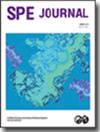Solution Gas/Oil Ratio Prediction from Pressure/Volume/Temperature Data Using Machine Learning Algorithms
IF 3.2
3区 工程技术
Q1 ENGINEERING, PETROLEUM
引用次数: 1
Abstract
Summary Many methods have been developed to determine the solution gas/oil ratio (Rs), starting with experiments, followed by empirical correlations establishments, and recently with machine learning applications receiving much interest due to their ability to produce precise results compared with empirical correlations. In this paper, the group method of data handling (GMDH) and the enhanced GMDH based on discrete differential evolution (GMDH-DDE) are used for the first time to estimate the Rs and to provide a correlation to the laboratory measured Rs from bubblepoint pressure (Pb), oil API gravity (API), gas-specific gravity (γg), and reservoir temperature (T) without crude oil properties. These two methods are compared with backpropagation neural networks (BPNN). The reason for using the hybrid GMDH (GMDH-DDE) is to overcome the drawbacks of the GMDH, such as the method used to calculate neuron weights (i.e., quadratic polynomial transfer function), which seems to have inaccuracies. Also, in selecting model inputs, the GMDH tends to choose the most appropriate inputs for the model; however, the selection criteria are not straightforward and may affect the final results. Furthermore, the GMDH has a multicollinearity problem, affecting model coefficient stability and overfitting problems, etc. A total of 420 data sets from the Mpyo oil field were used, with 70% used for training and 30% used for testing. According to the findings, the GMDH-DDE outperformed both the GMDH and BPNN. In comparison with the GMDH and BPNN, the GMDH-DDE has a higher correlation coefficient (R), lower root-mean-square error (RMSE), and lower mean absolute error (MAE). During training, R, RMSE, and MAE were 0.9849, 0.090, and 0.010, respectively, and during testing, R = 0.9603, RMSE = 0.290, and MAE = 0.017. The second-best technique (GMDH) produces R, RMSE, and MAE values of 0.9611, 0.122, and 0.032 in training, and R = 0.9438, RMSE = 0.349, and MAE = 0.055 in testing. Furthermore, the GMDH-DDE used less computational time (1.32 seconds) compared with the GMDH (2.01 seconds) and BPNN (4.96 seconds), proving that the GMDH-DDE has accurate and fast convergence compared with the GMDH and BPNN. These findings show that the GMDH-DDE and GMDH can be adopted as alternative methods for predicting the Rs.利用机器学习算法从压力/体积/温度数据预测溶液气/油比
已经开发了许多方法来确定溶液气/油比(Rs),从实验开始,然后是经验相关性的建立,最近机器学习应用因其与经验相关性相比能够产生精确的结果而受到广泛关注。本文首次采用分组数据处理方法(GMDH)和基于离散差分演化的改进GMDH (GMDH- dde)来估计Rs,并在不考虑原油物性的情况下,通过气泡点压力(Pb)、原油API比重(API)、气体比重(γg)和储层温度(T)与实验室测量的Rs进行了相关性分析。将这两种方法与反向传播神经网络(BPNN)进行了比较。使用混合GMDH (GMDH- dde)的原因是为了克服GMDH的缺点,例如用于计算神经元权重的方法(即二次多项式传递函数)似乎存在不准确性。此外,在选择模型输入时,GMDH倾向于为模型选择最合适的输入;然而,选择标准并不简单,可能会影响最终结果。此外,GMDH存在多重共线性问题,影响模型系数稳定性和过拟合问题等。总共使用了来自Mpyo油田的420个数据集,其中70%用于训练,30%用于测试。根据研究结果,GMDH- dde优于GMDH和BPNN。与GMDH和BPNN相比,GMDH- dde具有更高的相关系数(R)、更低的均方根误差(RMSE)和更低的平均绝对误差(MAE)。训练时R、RMSE和MAE分别为0.9849、0.090和0.010,检验时R = 0.9603、RMSE = 0.290、MAE = 0.017。次优技术(GMDH)在训练中的R、RMSE和MAE值分别为0.9611、0.122和0.032,在测试中的R = 0.9438、RMSE = 0.349和MAE = 0.055。与GMDH (2.01 s)和BPNN (4.96 s)相比,GMDH- dde的计算时间(1.32 s)更短,证明了GMDH- dde与GMDH和BPNN相比具有准确和快速的收敛性。这些结果表明GMDH- dde和GMDH可以作为预测Rs的替代方法。
本文章由计算机程序翻译,如有差异,请以英文原文为准。
求助全文
约1分钟内获得全文
求助全文
来源期刊

SPE Journal
工程技术-工程:石油
CiteScore
7.20
自引率
11.10%
发文量
229
审稿时长
4.5 months
期刊介绍:
Covers theories and emerging concepts spanning all aspects of engineering for oil and gas exploration and production, including reservoir characterization, multiphase flow, drilling dynamics, well architecture, gas well deliverability, numerical simulation, enhanced oil recovery, CO2 sequestration, and benchmarking and performance indicators.
 求助内容:
求助内容: 应助结果提醒方式:
应助结果提醒方式:


